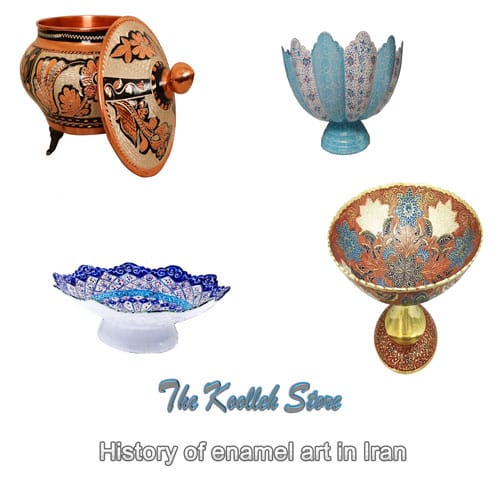History of enamel art in Iran

Enamel is the brilliant art of fire and earth, with its bright and mature colors dating back to 1500 BC and its appearance on metal during the sixth to fourth centuries BC and after 500 BC. It can be seen. The art of enameling in Iran has been more prominent than in other places, and one of the oldest examples of it in the Safavid era has been mentioned by Chardin, a French tourist. Pale and green and yellow and red.
It is difficult to say when the art of enameling became popular in Iran, because from the pre-Safavid era (tenth century AH) there are no examples of enameling and there are no significant examples from the Safavid period. However, during the Qajar period, there was a small amount of enameling and objects such as hookahs, hookah jars, and hookah jugs and windbreaks were enamelled. There were enameled hookahs in the court of the Qajar kings, especially Nasser al-Din Shah, who used to smoke hookahs. There are also such enameled objects in the houses of aristocrats and elders of that time. Other items such as belts, pelvic sunshades, snuffboxes, watering cans, earrings, teardrops and cans of enameled cigarettes are also available.
The history of enamel art in Iran dates back to the Parthian and Sassanid eras; However, its use at the beginning of Islam was not clear until before the rule of the Mongol Muslim Ilkhan, Ghazan Khan (694 to 703 AH). The king soon mastered the science of chemistry and, unlike his predecessors who spent large sums of money on finding elixirs, preferred to spend his knowledge and efforts on the art of enameling. The art of enameling can be considered one of the most creative human inventions.
Enamel can also be applied to gold and silver objects, but it is basically done on copper. There are several steps you can take to begin the process of preparation. In this way, first what they want to enamel in any form and size must be made by a specialist coppersmith, and after it is made, the enamel master gives it a white glaze, usually three to three. It is glazed four times, and each time the object goes into the furnace, it sees about 700 degrees Celsius to prove the color of the glaze. Then it is painted in different colors. The open object then goes into the furnace and sees a temperature of about 400 to 500 degrees Fahrenheit.
Gold is also used to make red enamel. The green color of enamel is obtained from copper and its yellow color is obtained from mung bean flowers. The blue and turquoise colors are made of metals and the white ones are made of a special color, which is well received in the Iraqi city of Samarra. Because enameling is an art that has flourished in recent years, and its great masters have emerged in the Pahlavi era, now the greatest master of enameling in Isfahan is Mr. Shokrullah Saniezadeh.
The popularization of the enamel industry in Isfahan dates back to the Pahlavi era and around 1310 AD, and especially during the last thirty years, this industry was developed by one of the master professors of art and Isfahan named Mr. Shokrallah Sanizadeh and students were trained in this school, each of whom They opened another window for the art of enameling. So far, about 500 masters and workers are engaged in making enamel objects. Most of the items on the market today are: earrings, tiny breasts, necklaces, rings, large and small boxes for women’s makeup, cigarette cans, inlaid boxes and enamels, tea service and … enamel eating – syrup Enamel Eating – Enamel Bubbles – Enamel Platform – Enamel Vase in Different Sizes – Large and Small Enamel Paintings with Other Arts such as Goldsmithing, Inlay and Miniature Combination of Enameled Doors, Windows and Shrines for Shrines of Shiite Imams in Karbala And Najaf, Samarra, Mashhad, Qom, Hazrat Abdolazim and other holy places.

